How to Upload a File to Unix Server Bitvise
Mar xviii, 2022
Volition M.
8min Read
5 Steps to Get Your New Virtual Private Server (VPS) Set to Utilize

Making the jump from shared hosting to a Virtual Private Server (VPS) is a relatively easy move. Notwithstanding, learning how to set up up a VPS can exist a fleck trickier, especially if you've never used the command line earlier.
Download Complete Linux Cheat Sheet
In this article, we're going to walk you through how to prepare up a VPS in five steps:
- Learning how to log into your VPS via Secure Shell (SSH) access.
- Updating your server.
- Creating a new user and modifying its privileges.
- Enabling public key authentication.
- Setting up a firewall for your VPS.
Before nosotros get into the technical details, though, we're going to explicate why you lot'll need to configure your new virtual server. Let's talk almost how to set up a VPS!
Why Y'all Should Configure Your New VPS
Normally, when you sign up for a basic hosting plan, your provider will prepare all the software you'll demand to use it. With shared hosting, for example, y'all'll probably get access to a control panel for your account right abroad:
These hosting command panels provide you with all the options you need to configure your account. However, in most cases, you won't become the risk to tweak your server's actual settings, because other people are besides using the same motorcar.
With a VPS, on the other hand, you get a server environment all to yourself. In almost cases, your host will simply go so far as to gear up basic server software – such equally Apache or Nginx – and the rest is upward to you. That ways you'll probably need to go through a few extra steps to get your server 'ready', such as:
- Deciding when should you start using VPS.
- Learning how to connect to it and issue commands.
- Figuring out how to install new software and perform updates.
- Configuring new user accounts (if needed).
- Setting upward a firewall.
When we talk near issuing commands to your server, we're referring to something like this:

Unremarkably, yous'll interact with your VPS using the command line instead of a Graphical User Interface (GUI). That tin can be intimidating at first, but you'll speedily get used to it if yous don't mind Googling around for the right commands and post-obit some unproblematic tutorials.
Youtinlikewise set upwards hosting control panels that volition enable you to interact with your server using a GUI. However, we're non going to cover that in this article, since using the control line is often the more than efficient route. Plus, learning how to apply uncomplicated commands volition teach you a lot nigh server direction, which will almost certainly come in handy as your site grows.
5 Steps to Configure Your New VPS and Become It Ready to Use
As you lot may know, the vast majority of web servers run on Unix-based systems. That means you'll demand to use commands tailored to that type of Operating System (Os), which are not the same every bit those you lot'd use on a Windows machine. If you want to learn more most Windows server management, check out this guide for more details.
With that out of the manner, permit's talk about how to gear up a VPS!
Step 1: Learn How to Log into Your VPS via Secure Vanquish (SSH) Access
In that location are several ways you can connect to a website, across using a browser. For instance, you can utilize File Transfer Protocol (FTP), which enables yous to upload, download, and edit files on your server:
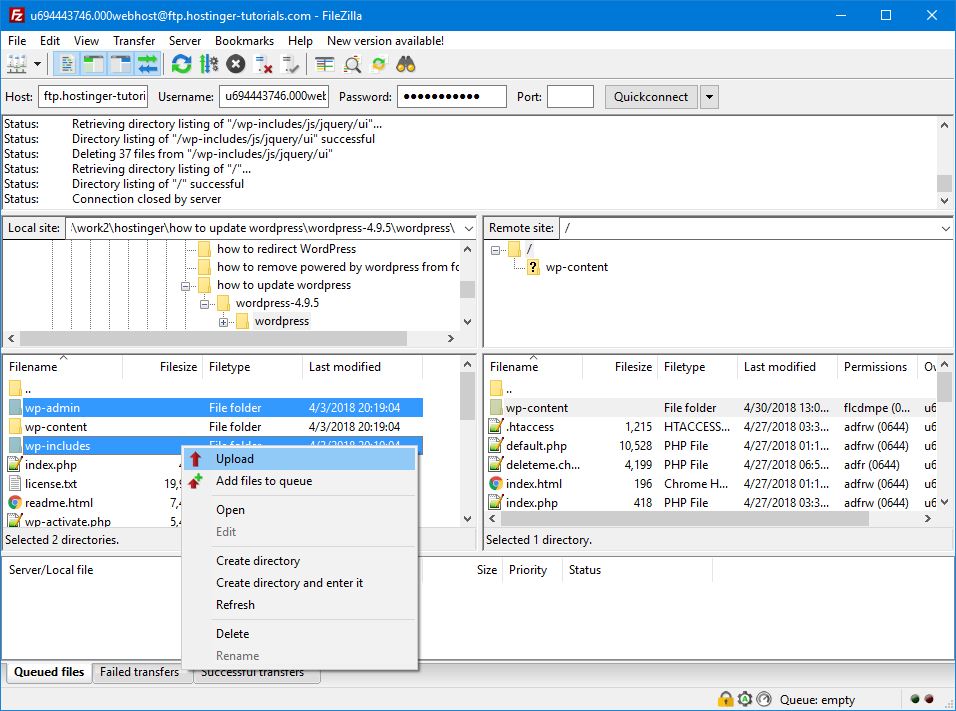
While FTP can be very useful, the protocol doesn't enable you to issue commands to your server. For that, yous'll need to apply Secure Beat (SSH) access, which is a dissimilar blazon of protocol that provides you with access to remote servers.
Once you connect to a server via SSH, yous'll be able to outcome commands to information technology. SSH is besides renown for its strong encryption and authentication protocols, which make it highly secure. By learning how to utilize SSH, you'll be taking your first steps into server management.
Once you sign up for a VPS plan, your web host should provide y'all with a prepare of credentials, including:
- Your server's IP address
- A username (ordinarilyroot)
- A password for yourroot account
In case you're not familiar with the term, aroot(orsuperuser) account is a user with full privileges and access on a specific organisation. You tin think of it every bit the equivalent of an administrator, only with fifty-fifty more power.
When you set a VPS, you'll start off with a singleroot account, which is the one you'll apply to make the initial connection. If you're using a Unix-based Os on your end, you can connect to your server directly from the command line.
Nonetheless, if you lot're using Windows, you'll get-go need to install an SSH client. We're partial to ii clients in particular, the first of which is called Bitvise:

If yous're looking for a simple interface that resembles the classic Windows style, you tin can't get wrong with Bitvise. However, you'll be doing most of your work within the command line, so the way doesn't matter much.
We're also big fans of PuTTY, which features a far more minimal interface. Nonetheless, it offers a lot of additional configuration options, making it preferable if yous really desire to dip your toes into server direction.
For the balance of this tutorial, we're going to be using PuTTY in our examples. With that in mind, go ahead and install the program, and so execute it. You'll see a window like this ane:
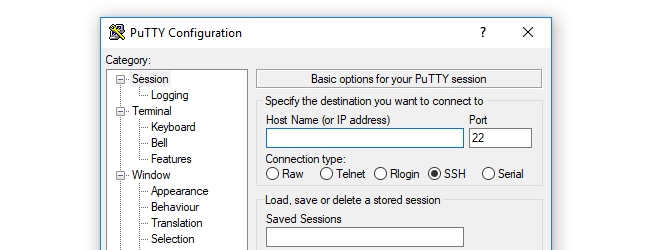
At this stage, you need to enter your server's IP address into theHost Name (or IP address)field, and leave thePortsetting to the default value of22:

Aside from SSH connections, port 22 is also used for secure logins and Secure File Transfer Protocol (SFTP). You can also modify the SSH port if y'all like.
You may notice that there's an option to select which connection type you desire to use below the IP field. ChooseSSH, and then you tin can go ahead and hit theOpenbutton.
A command line window volition open now, and you'll run across a prompt to enter your login information. In this example, that will berootand its corresponding password:

If the data entered is right, you'll see a brief summary of your server's details, and a prompt to enter more commands:
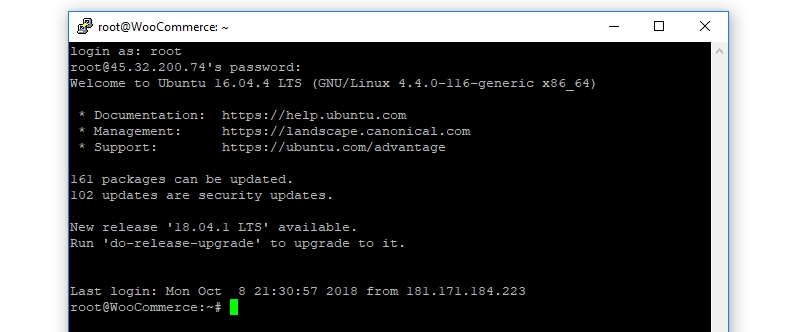
That's information technology for the outset step of how to fix upward a VPS. Don't shut the command line window yet, however, since we still have piece of work to practice.
Pace 2: Update Your Server
Once you log into your VPS, you'll see a message that tells you lot if there are whatever 'packages' or security updates available:

Packages are essentially software in Unix-speak. When it comes to any arrangement, information technology's always important to proceed its components upward to date, and servers are no exception.
If you lot're using outdated software, you open upward your server (and website) to security vulnerabilities. Plus, you might be missing out on new features or improved performance. That's why the first matter you'll desire to do is update your server'due south packages, and download whatever pending security patches.
To get started, type in theapt updatecontrol and hit Enter. At present, your server volition double-bank check what packages demand upgrading. Once it's done, enter apt upgrade, which will update your server'due south packages:
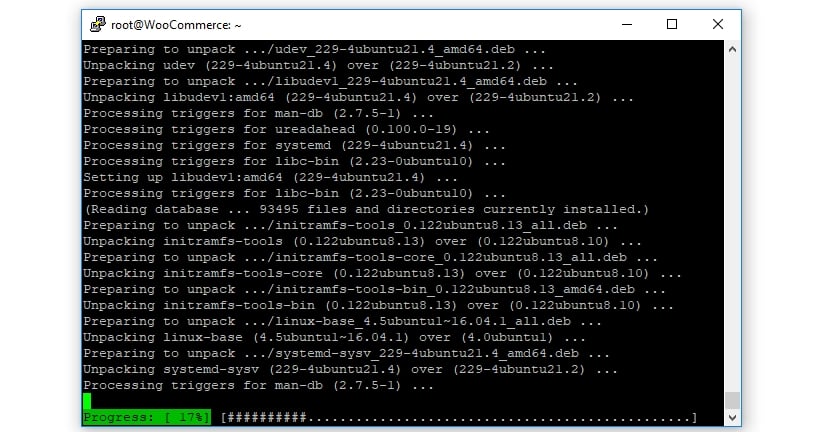
This process might accept a while, depending on how many updates your server needs to install. So sit down back, take hold of some coffee, and look for information technology to exist washed.
One time all your packages are up to date, you should go ahead and restart your server using therebootcontrol. Then, shut the command line window. Wait a minute or 2, and log back in using PuTTY (or your client of choice).
If everything went according to programme, there shouldn't be any more than available updates listed. That means we tin can movement on to the adjacent step of learning how to set upwardly a VPS.
Step iii: Create a New User and Alter Its Privileges
When you set a VPS, you beginning off with arootuser, which is the account you've been using and so far. However, it's normally a skillful idea to prepare some other user account with superuser privileges.
The reason for this is that therootaccount can crusade some severe impairment if you're not sure what y'all're doing. Arootaccount has total access to all of your system'due south settings, so one wrong control can create serious problems.
A regular user account with superuser privileges, on the other hand, needs to add thesudoprefix to any command it wishes to run using authoritative privileges. This may seem like a small change, simply it makes a huge difference. With this approach, you'll demand to recall twice before running whatsoever command using thesudoprefix, which can help you lot avoid mishaps.
Become ahead and set up that new user at present by entering the post-obit command. You'll want to replace the second part with whatever username y'all'd like to use:
adduser yournewusername
Then, blazon in this line to add together that user to thesudogrouping, which volition give information technology superuser privileges (once more, replacing the placeholder with your new username):
# usermod -aG sudo yournewusername
At present, all that's left is to prepare a countersign for this account. However, there's a method that'southward far more secure than using a normal countersign, which is what we'll look at side by side.
Pace 4: Enable Public Key Authentication
Public primal hallmark is a technique that'south arguably more secure than regular passwords. With this approach, you generate a set of both 'public' and 'private' keys.
Your server volition store your public central and utilise it to authenticate the individual one, which only you will take access to as a file on your figurer. Once yous set upwardly public central hallmark, you lot'll need both the individual key and a passphrase to log in, which increases security significantly.
To generate SSH keys in Windows, you tin can use the PuTTYgen app, which will accept been installed when you set the client earlier (for details nearly how to do this on Linux/Unix systems, bank check out this guide). Expect amidst your programs for it and run the PuTTYgen app now, which should wait similar this:
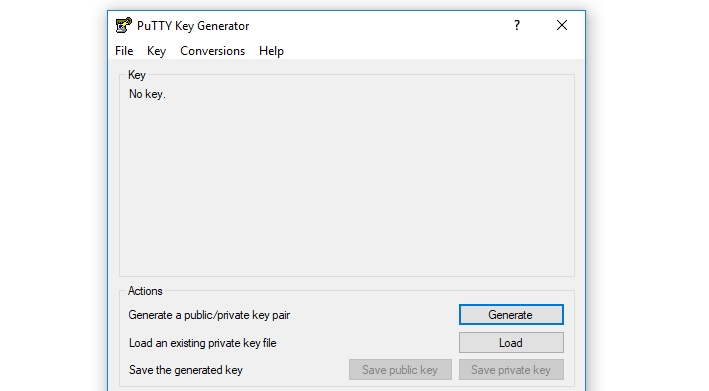
It's fine to apply the default settings for your key pair, and so go alee and click on theGeneratebutton at present. To make your key more unique, the program will ask you to move your mouse around to randomize it, which is pretty cool:
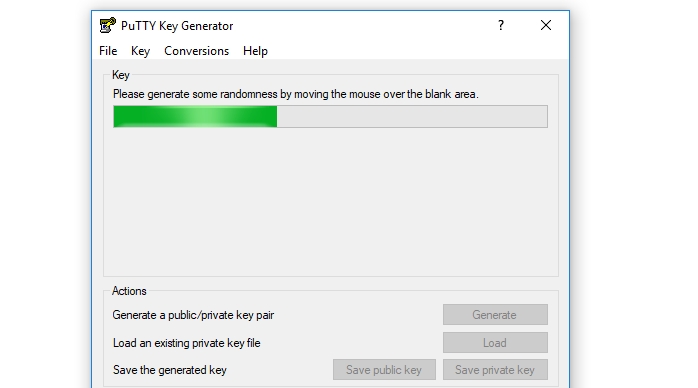
Next, the program will show you the public central it generated for y'all. Before yous do annihilation else, go ahead and set upward an accompanying passphrase for it, which will act equally a password alongside the key:
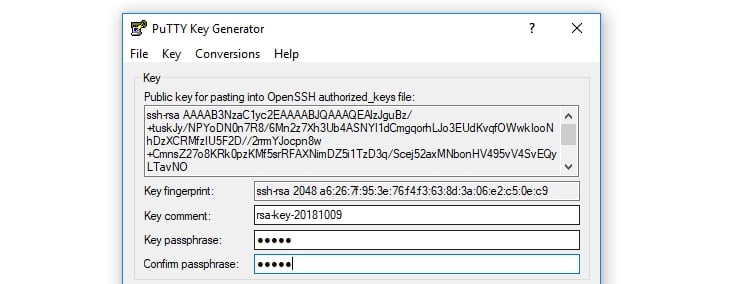
At present, become ahead and hit theSave individual keybutton, and save the resulting file to your computer. You'll likewise need to copy your public key in a moment, so don't close this window just yet.
And so, log dorsum into your server using the originalrootuser, and move to your new account's home directory using # su – yournewusername. The command line will now reflect your new user:

After that, yous'll need to run a series of commands in order, which will create a new folder for your public primal, restrict that folder'southward permissions, and save your key:
mkdir ~/.ssh chmod 700 ~/.ssh nano ~/.ssh/authorized_keys
That final command will open up the Nano editor, enabling you to modify the newauthorized_keysfile on your server. Go ahead and re-create your public central now from the PuTTYgen window, and paste it in here.
Once the key is gear up, hit CTRL + Xto shut the editor, and enterYwhen it asks you to confirm the changes to the file. Then, blazon in the following two commands:
chmod 600 ~/.ssh/authorized_keys get out
Those volition modify the permissions for the file you lot just edited, so return you to therootuser.
Next, you'll need to configure PuTTY to use your private key when y'all connect to your server so that it can recognize you lot. To do this, return to the app's main screen and go to theConnection › SSH › Authdepartment. Inside, you'll find a field calledPrivate key file for authentication:

Click on theScanpush, and and so locate the private primal file you stored on your calculator. Select it, and y'all're adept to go.
Finally, you need to tell your server to disable the default password-simply authentication method for the new user y'all just ready upwardly. To do that, log into your server every bit the new user via SSH, and run this command:
sudo nano /etc/ssh/sshd_config
This will open thesshd_configfile using the Nano editor. Look for the line that readsPasswordAuthenticationwithin that file, and delete the # sign before information technology. And then modify its value fromYestoNo, so it reads like this:
PasswordAuthentication no
Save the changes to the file, and reboot your server. The next time you attempt to log in, y'all'll only be able to do so using your individual fundamental and passphrase.
Step 5: Gear up Up a Firewall for Your VPS
We've covered a lot of ground so far about how to set up a VPS. However, at that place's withal one final stride to perform if you lot desire to keep your server secure. That is to enable a firewall for it.
You can practise this using the iptables program, which enables you to fix up rules that restrict traffic to and from your server. This procedure is a bit involved, though, so nosotros recommend that you check out our full guide on how to set upwardly iptables and configure the program properly.
This step may seem similar overkill at first. With Iptables, however, you'll be able to restrict which ports enable traffic to access your server. This will stop a lot of attacks in their tracks. Plus, it'southward a i-time setup process, so it pays to do it right away.
Conclusion
Learning how to set up up a VPS after upgrading from shared hosting is similar leaving the kiddie pool to dive into an Olympic-sized i. You have a lot more than room and features to play with, but you'll need to find your footing before you tin start having fun. At present that you know how to configure your VPS, y'all've become acquainted with the command line, which will make information technology a lot easier to prepare everything up to your liking.
Do you have whatsoever questions almost how to set upward a VPS? Allow's talk near them in the comments department below!
Source: https://www.hostinger.com/tutorials/getting-started-with-vps-hosting
0 Response to "How to Upload a File to Unix Server Bitvise"
Postar um comentário